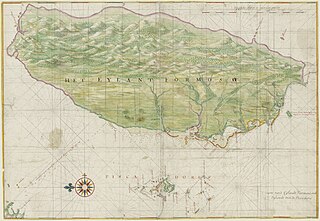
The written history of Kaohsiung can be traced back to the early 17th century, though archeological studies have found signs of human activity in the region from as long as 7000 years ago. Prior to the 17th century, the region was inhabited by the Makatau clan of the Siraya aboriginal tribe, who settled on what they named Ta-kau Isle ; "Takau" meaning "bamboo forest" in the aboriginal language. Dutch settlers colonizing Taiwan in 1624 referred to the region as Tankoya and named the harbor Tancoia. The first Chinese records of the region were written in 1603 by Chen Di, a member of Ming admiral Shen You-rong's expedition to rid the waters around Taiwan and Penghu of pirates. In his report on the "Eastern Barbarian Lands", Chen Di referred to a Ta-kau Isle:

The Taihoku Air Raid that took place on 31 May 1945 was the largest Allied air raid on the city of Taihoku during World War II. Despite efforts by Allied planners to minimize civilian casualties, many residents were killed in the raid and tens of thousands wounded or displaced.
Chen-Yuan Lee, was a Taiwanese pharmacologist and political activist. He is famous for his research on snake venom. He was a recipient of the prestigious Redi Award from the International Society on Toxinology (IST), and was also a former president of the society. He was a former dean of the National Taiwan University College of Medicine. After his retirement from researching, he focused on participating in the Taiwan independence movement and many democratic movement. Lee had founded many political organizations such as the "100 Action Union" (100行動聯盟), Foundation of Medical Professionals Alliance in Taiwan. He was also the first chairperson of the Taiwan Independence Party.
Hukou incident is an attempted coup d'état that took place on 21 January 1964 at Hukou, Hsinchu, Taiwan. During a staff meeting at the 1st Armor Division headquarter, General Chao Chih-hwa (趙志華), then deputy commander of the armored battle group, criticized General Chou Chih-jo (周至柔), then Chief of the General Staff, on charges of corruption, and encouraged fellow officers at the meeting to revolt. He was reported as saying "Our leader is being deceived by treacherous people, we must move our forces to Taipei to remove them." ("当今主上为小人所蒙蔽,我们要把部队开到台北勤王清君侧") He was promptly arrested by two political warfare officers, but the army nonetheless received erroneous information that the 1st Armor Division was on the move, and had deployed troops to intercept the "rebels forces" that did not exist.

The cultural history of Taiwan can be traced back to prehistoric Stone Age. Later the development of written languages made it easier to maintain traditions of the Taiwanese culture.
Tan Kun-giok, also known as Chen Chun-yu in Mandarin, was a Taiwanese songwriter and author born in Dadaocheng. He wrote many Hokkien songs such as Thiau Bu Si Tai (跳舞時代) and Siu Be Toa Kang Tiau (想要彈像調), and had served as an officer of the Columbia Record, a Japanese-owned disc company. Tan could speak Mandarin Chinese fluently, he was an introducer of Mandarin to postwar Taiwan. Chen died from hepatic cancer in 1963.
Taiyuan Basin is located around the southern tail of Hai'an Range of eastern Taiwan. It is a place where the Amis are living in as a compact community. Whole basin located in the Dunghe Township of Taitung County. It has an archaeological site named Taiyuan site (泰源遺址), a part of the Cilin Culture (麒麟文化).

Sun-sun, born Lâu Chheng-hiong (劉清香), was a Taiwanese popular singer.
The European Federation of Taiwanese Associations is a federation, which combines several associations by Taiwanese people in each European country. The object is to promote friendship among those European associations, support mutual corporation and continuing care for Taiwan's development and trends. At the present is 謝偉群 director general of EFTA, who lives in Germany.
Taiwanese campus folk song, campus folk song, or campus folk rock is a genre of Taiwanese Music with its roots as student songs in the campuses of Taiwanese universities during the 1970s. The genre was highly popular from the mid-1970s to the early 1990, with its focus on themes from the Chinese cultural sphere in reaction to the prevalence of Western rock music in Taiwan as well as being edged out by the People's Republic of China from the United Nations and from the world political stage This genre of music became very popular in mainland China during the 1990s with the increased cultural exchanges between Taiwan and the mainland during this period.

The Niumatou Site is an archaeological site during the mid Neolithic period in Qingshui District, Taichung, Taiwan. It is the oldest archaeological site in central Taiwan. The site has been designated as a historical relic by then Taichung County Government.

The Khóo Tsú-song old house is a historical site located in Keelung, Taiwan. The place is named after its main owner, Khóo Tsú-song (1874-1945), a Taiwanese notable who has been in charge of Keelung city as well as Taipei province during the Japanese period. Khóo Tsú-song (許梓桑) is his name pronounced in Hokkien, his mother tongue, but he is more well-known today as Hsu Tsu-sun, which is the same name with a pronunciation in Mandarin. Adding to his political responsibilities, he was also a well-known personality in artistic circles, especially connected with poets from all over the country.

The House of Koxinga or the Zheng dynasty was the reigning family of the Kingdom of Tungning in Taiwan. They played a significant role in the history of East Asia and Southeast Asia, particularly in the seventeenth century.

The Fengbitou Archaeological Site is an archaeological site in Linyuan District, Kaohsiung, Taiwan.
Joseph Nan-Hong Kuo is a Taiwanese film director best known for his Hong Kong based kung fu films of the 1970s.

In Taiwan, the North–South divide refers to the political and economic differences between northern and southern Taiwan.










